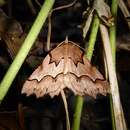en
names in breadcrumbs


Ischalis fortinata (also known as the zigzag fern looper)[3] is a species of moth in the family Geometridae.[4][5] It was first described by Achille Guenée in 1868.[2] This species is endemic to New Zealand.
This species was first described by Achille Guenée in 1868 using a specimen collected by R. W. Fereday likely at Akaroa on the Banks Peninsula and named Polygonia fortinata.[2][6] In 1875 Felder & Rogenhofer thinking they were describing a new species tentatively named it as Caustaloma ziczac.[7] This name was synonymised by Edward Meyrick in 1883. The male holotype specimen is held at the Natural History Museum, London.[2]
The mature larva of this species is a reddish-brown colour, with greenish reddish mottling, has a hairy appearance, and is between 25 and 30 mm long.[8][9] Along the back of the larva there is a black edged, brown line and a number of black and white marks on a number of segments.[9] It forms a thin cocoon on the fronds of its host plants and overwinters as a pupa.[9]
Guenée described the adults of this species as follows:
This charming Phalenite is a most curious species. The wings are cut in an altogether peculiar manner. Superior having each at the apex two triangular excisions, the first of which is very deep (the inferior have also two excisions near the middle) ; they are testaceous-yellow, more or less tinged with violet, and with two deep black, well marked median lines ; the first line forms, above and beneath the median nervure, two very acute angles ; the second forms also two corresponding angles, but more open and blunter, and is bordered on the inside with paler ; between the two lines is a brown mai-k on the costa, and a black dot beneath it ; opposite to the second angle of the elbowed line are two more black dots, and finally some black markings near the terminal excision : inferior with only one line, which becomes obliterated near the middle of the wing. In well-marked specimens there is also a pale subterminal line common to all the wings. The under-side is of a more lively yellow, strongly varied with ferruginous, with the same lines and dots as the upper-side, but less marked and reddish : on the inferior is a median band, toothed inferiorily and surmounted, in the cellule, by an oval ferruginous dot, traversed by a fine white line, which divides the cellule in two parts, and is prolonged to the apical margin. The whole body is coloured as in the wings.[6]
This species is endemic to New Zealand.[1] It has been recorded on the North and South Islands and is abundant in native forest in the far south of the South Island.[9]
Eggs of I. fortinata are laid on their leaves of its host species.[9] The adult moth is on the wing between January and March.[8]
This species can be found in native forest.[9] The larval hosts of this species include Polystichum vestitum and Polystrichum richardii.[8] The larvae feed all year round.[8]
Ischalis fortinata (also known as the zigzag fern looper) is a species of moth in the family Geometridae. It was first described by Achille Guenée in 1868. This species is endemic to New Zealand.